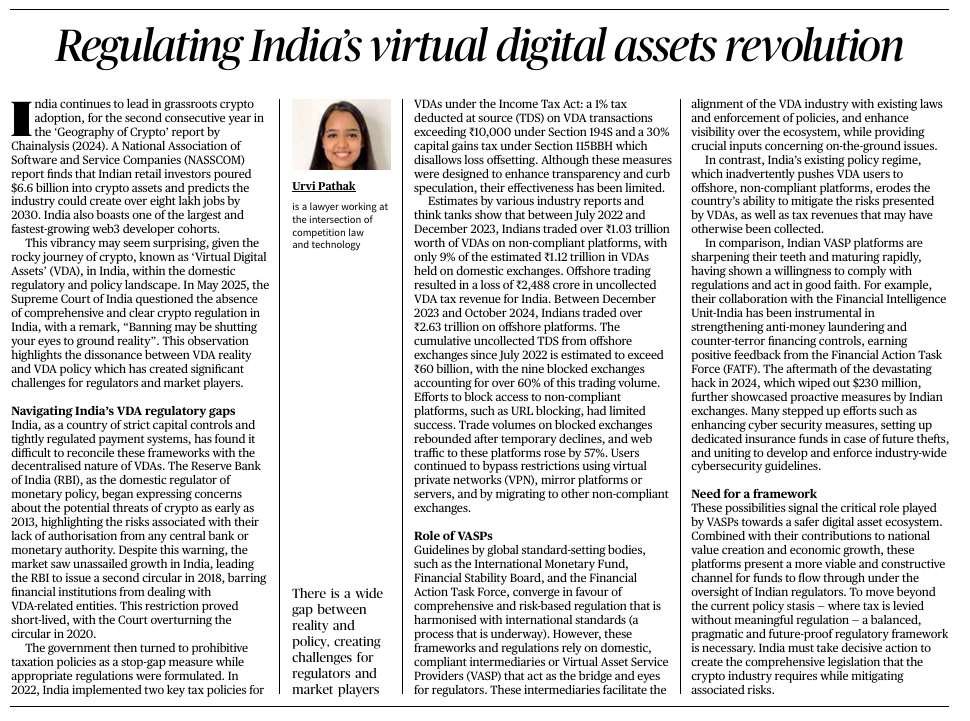Context & Background
- India ranks #1 in crypto adoption globally (Chainalysis 2024).
- $6.6 billion invested by Indian retail investors (NASSCOM).
- 8 lakh jobs projected by 2030 in crypto/Web3 sector.
- Supreme Court (May 2025): “Banning may be shutting your eyes to ground reality.”
- Regulatory Gaps
- No clear regulatory framework for VDAs in India.
- RBI warnings since 2013 → circulars banning banks from crypto dealings.
- Supreme Court overturned RBI ban in 2020.
- Lack of central bank or monetary authority control over VDAs.
- No unified licensing or compliance architecture.
4. Taxation Measures
- 2022: India imposed two major taxes:
- 30% tax on crypto gains.
- 1% TDS on all VDA transactions (Section 194S).
- 30% tax on crypto gains.
- Section 115BBH: Disallows loss offsets and deductions.
- Result: Offshore trading boomed → ₹2.63 trillion traded offshore vs ₹1.03 trillion on Indian platforms.
5. Challenges from Current Policy
- Over-regulation without clarity → shift to offshore/non-compliant platforms.
- Revenue loss due to tax evasion and VPN-based trading.
- User evasion tactics: VPNs, mirror platforms, foreign wallets.
- India’s stance contrasts with jurisdictions offering sandbox models and licensing (e.g., UAE, Singapore).
6. Law Enforcement & Cybersecurity Gaps
- Lack of cross-border coordination, leading to fraud and fund diversion.
- VDA scams in 2024: Losses over $230 million.
- Weak cyber incident reporting, no dedicated fund insurance system.
7. Role of International Bodies
- FATF recommendations on AML/CFT compliance.
- India’s progress cited through Financial Intelligence Unit–India (FIU) collaboration with Indian VASPs.
- Emphasis on “travel rule,” KYC compliance, and reporting standards.
8. Need for a Future-Proof Framework
- Balanced regulation combining:
- Innovation enablement
- Tax compliance
- Consumer protection
- Investor education
- Innovation enablement
- Suggests establishing a dedicated digital assets regulatory body or expanding SEBI’s jurisdiction.
- Governance & Ethical Keywords
- Technological neutrality
- Regulatory sandbox
- Crypto-tax dilemma
- Decentralised risk, centralised impact
- User protection vs innovation
- Digital sovereignty
- Inter-agency coordination
- Responsible financial innovation
10. Way Forward
- Develop a unified regulatory framework (possibly under SEBI or a new crypto regulatory authority).
- Enable regulated Indian VASP platforms to attract global capital.
- Link crypto regulation to India’s fintech and digital public infrastructure ecosystem (like UPI, ONDC).
- Promote safe innovation, not surveillance-led regulation.
PRACTICE QUESTION:
Critically analyse the impact of India’s current tax and compliance regime on the domestic virtual digital asset ecosystem. How does it influence offshore migration and revenue losses?
(12.5 marks / 200 words)


